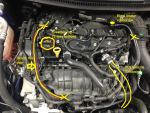Hi all, after trawling through thread after thread of discussion regarding the PCV system, I think i've managed to come to terms with how it works and a possible solution that would work better than VTA, yet still keep the PCV and CCV system entirely separated from the intake.
I have attached a very poorly drawn sketch of how I think everything could work.
It involves:
Completely deleting line 1 (Left, PCV) and capping off both ends
Capping off line 2 (right, CCV) at the intake, and re-assigning the port where it used to connect to on the engine by placing a hose which would run to a venturi fitting in the exhaust which would provide a small vacuum, w/ check valve.
Replacing oil cap with a breather that allows air to flow freely into (or out of, in the event of no vacuum from the venturi fitting) the crank cover, effectively doing the job that line 2 used to do, bringing in fresh air while the PCV side of the system was venting.

Also just wondering what the third pipe in the middle that connects the cover to something near the crankcase does?
I think this will be effective because the PCV system no longer has any connection I can see to the intake system, meaning there should be no unmetered air loss/gain.
The system needs to be effective because the car is primarily a daily driver.
To answer some questions:
I am aware its illegal
I want to avoid the use of catch cans
It's a bit out there so just wanted some input from someone in the know.
Cheers
I have attached a very poorly drawn sketch of how I think everything could work.
It involves:
Completely deleting line 1 (Left, PCV) and capping off both ends
Capping off line 2 (right, CCV) at the intake, and re-assigning the port where it used to connect to on the engine by placing a hose which would run to a venturi fitting in the exhaust which would provide a small vacuum, w/ check valve.
Replacing oil cap with a breather that allows air to flow freely into (or out of, in the event of no vacuum from the venturi fitting) the crank cover, effectively doing the job that line 2 used to do, bringing in fresh air while the PCV side of the system was venting.

Also just wondering what the third pipe in the middle that connects the cover to something near the crankcase does?
I think this will be effective because the PCV system no longer has any connection I can see to the intake system, meaning there should be no unmetered air loss/gain.
The system needs to be effective because the car is primarily a daily driver.
To answer some questions:
I am aware its illegal
I want to avoid the use of catch cans
It's a bit out there so just wanted some input from someone in the know.
Cheers
